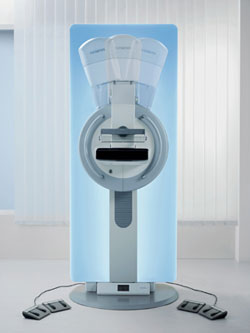Enhancing imaging capabilities with breast tomosynthesis

Siemens Healthcare has now integrated 3D tomosynthesis into its Mammomat Inspiration digital mammography platform. This technology compiles three-dimensional images of the breast and can therefore detect tumors even if hidden by overlapping tissue.
This enables a more accurate diagnosis than before and reduces the number of false positive findings. The first Mammomat systems with tomosynthesis have now been installed in Germany and in Belgium.
Dr. Renate Tewaag from Radprax – a group of practices specializing in radiology, nuclear medicine and radiation therapy – was the first radiologist in Germany to use this new Siemens technology.
“With tomosynthesis we are witnessing a fascinating further development in digital mammography. This 3D technology offers impressive improvements in the detection of detail, which benefit both patients and radiologists alike: We can be more certain in our diagnosis, while women being examined can feel more reassured”, explained Dr. Tewaag. “Tomosynthesis makes mammography less stressful for both the physician and patient. Based on current first impressions, additional examinations and interventions can be avoided with a clear conscience. Lesions hidden within the dense glandular tissue are identified at an earlier stage.”
So far, conventional analog mammography and digital full-field mammography was only able to display the three-dimensional anatomical structure of the breast on a two-dimensional level. This made diagnosis more difficult and limited the possibility of the physician identifying certain types of tumor; since, anatomical structures could overlap and obscure lesions. The 3D tomosynthesis technology in the Mammomat Inspiration overcomes these limitations: The technology acquires several projections of the breast from different angles using a fast detector based on amorphous Selenium (aSe) and uses this raw data to generate a 3D volume set. This enables a better analysis of the type and size of lesions as well as microcalcifications compared to conventional methods.
Tomosynthesis increases the sensitivity and specificity of mammography, as well as improving tumor differentiation and classification.
Tomosynthesis differs from conventional mammography in the same way that, for example, a CT scan (computer tomography) differs from a classical X-ray image. During the examination, the Xray tube moves in a 50-degree arc around the breast, taking 25 low-dose images. The images are then used as raw data to construct high-resolution 3D images. High spatial resolution and a wide acquisition angle result in the production of mammography images with unparalleled image quality.
The digital Mammomat Inspiration system with basic screening and diagnostic functions has been on the market since the end of 2007 and is widely used in hospitals and medical practices around the world. Mammomat Inspiration offers screening, diagnostics, stereotactic biopsy, and now tomosynthesis for the first time together on a single integrated digital platform. Any hospital or practice can purchase a screening device and add the biopsy and 3D tomosynthesis applications at a later time if necessary. Soon, all installed systems of this type can be upgraded on-site with the tomosynthesis function.
The Siemens Healthcare Sector is one of the world's largest suppliers to the healthcare industry and a trendsetter in medical imaging, laboratory diagnostics, medical information technology and hearing aids. Siemens is the only company to offer customers products and solutions for the entire range of patient care from a single source – from prevention and early detection to diagnosis, and on to treatment and aftercare. By optimizing clinical workflows for the most common diseases, Siemens also makes healthcare faster, better and more cost-effective. Siemens Healthcare employs some 49,000 employees worldwide and operates in over 130 countries. In fiscal year 2008 (to September 30), the Sector posted revenue of 11.2 billion euros and profit of 1.2 billion euros.
Media Contact
More Information:
http://www.siemens.com/healthcareAll latest news from the category: Medical Engineering
The development of medical equipment, products and technical procedures is characterized by high research and development costs in a variety of fields related to the study of human medicine.
innovations-report provides informative and stimulating reports and articles on topics ranging from imaging processes, cell and tissue techniques, optical techniques, implants, orthopedic aids, clinical and medical office equipment, dialysis systems and x-ray/radiation monitoring devices to endoscopy, ultrasound, surgical techniques, and dental materials.
Newest articles

Silicon Carbide Innovation Alliance to drive industrial-scale semiconductor work
Known for its ability to withstand extreme environments and high voltages, silicon carbide (SiC) is a semiconducting material made up of silicon and carbon atoms arranged into crystals that is…

New SPECT/CT technique shows impressive biomarker identification
…offers increased access for prostate cancer patients. A novel SPECT/CT acquisition method can accurately detect radiopharmaceutical biodistribution in a convenient manner for prostate cancer patients, opening the door for more…

How 3D printers can give robots a soft touch
Soft skin coverings and touch sensors have emerged as a promising feature for robots that are both safer and more intuitive for human interaction, but they are expensive and difficult…





















